When reusing greywater, you'll need to evaluate five key health factors. First, manage microbial growth and pathogens by using water within 24 hours. Second, be aware of chemical contaminants from household products that can accumulate in soil. Third, control storage time and temperature to prevent bacterial proliferation. Fourth, choose appropriate application methods to minimize exposure risks. Finally, monitor plant and soil interactions for signs of stress or harmful buildup. By addressing these factors, you'll create a safer greywater reuse system. Understanding the nuances of each factor can help you implement a more effective and health-conscious approach to water conservation.
Microbial Growth and Pathogens
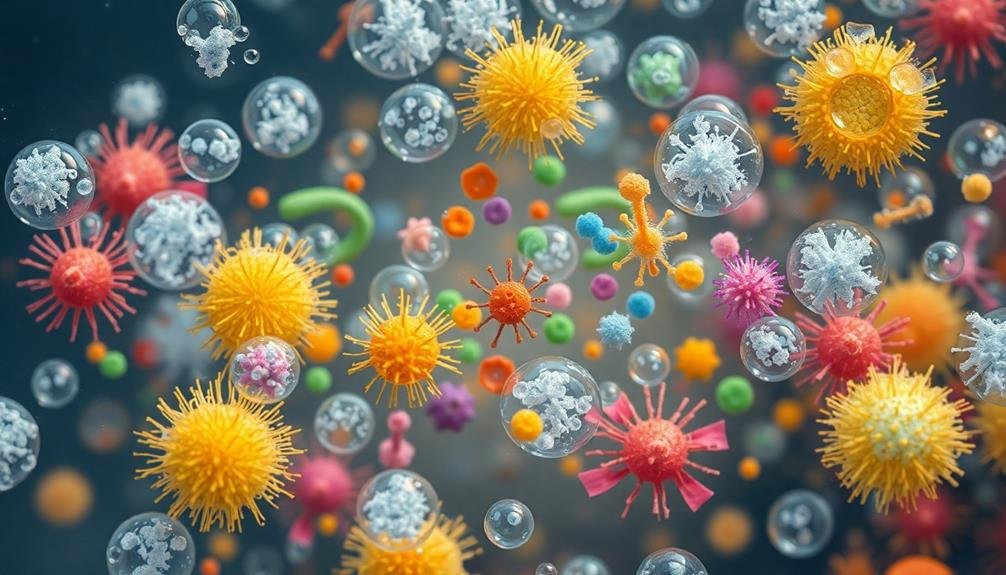
Three key concerns emerge when discussing microbial growth and pathogens in greywater reuse.
First, greywater can harbor various microorganisms, including bacteria, viruses, and parasites. These pathogens may originate from personal care products, food particles, or human contact. As greywater sits, these microbes can multiply rapidly, potentially increasing health risks.
Second, the storage time of greywater greatly impacts microbial growth. The longer you store greywater, the more time bacteria have to proliferate. It's essential to use greywater within 24 hours of collection to minimize this risk. If you can't use it immediately, consider treatment options like filtration or disinfection.
Third, the method of greywater application affects pathogen exposure. Surface irrigation increases the likelihood of human contact with potentially harmful microorganisms. To reduce risks, you should use subsurface irrigation systems or apply greywater directly to the soil, avoiding contact with edible parts of plants.
Chemical Contaminants in Greywater
While microbial growth poses significant health risks in greywater reuse, chemical contaminants present their own set of challenges.
You'll find various chemicals in greywater from household products like soaps, detergents, and personal care items. These can include phosphates, surfactants, boron, and sodium, which may harm plants or soil when used for irrigation.
You should be aware that greywater can also contain trace amounts of pharmaceuticals and hormones from personal care products. These substances can accumulate in soil and potentially enter the food chain if you're using greywater for crop irrigation.
Heavy metals are another concern. They can come from plumbing fixtures or certain cosmetics and may build up in soil over time. You'll need to monitor levels of lead, copper, and zinc to prevent toxicity in plants and potential health risks to humans.
Chlorine and other disinfectants used in tap water can persist in greywater. While they help control microbial growth, they may damage plants or disrupt beneficial soil microorganisms.
You should consider letting greywater sit for a day before use to allow chlorine to dissipate.
Storage Time and Temperature
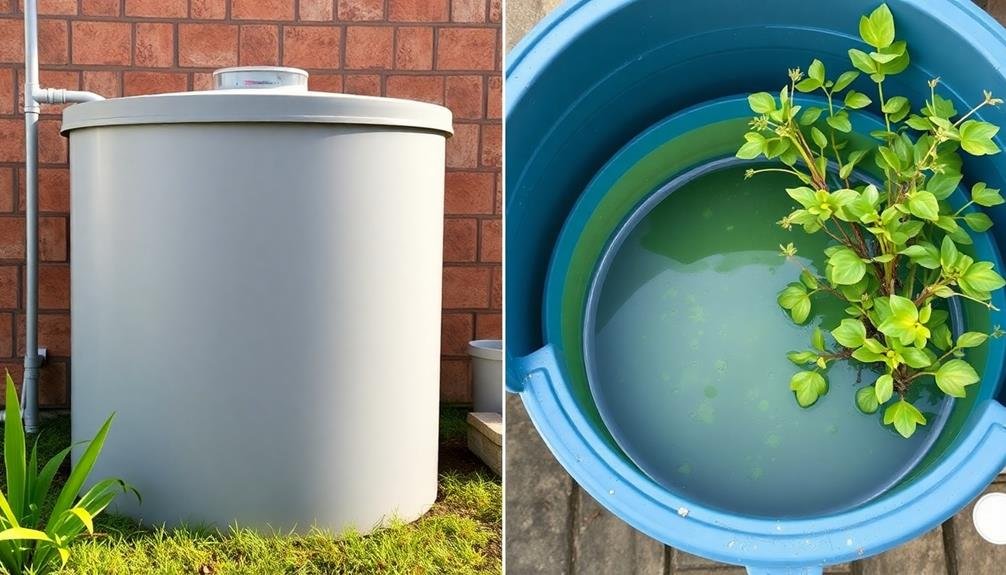
Time and temperature play essential roles in the safety of stored greywater. You'll need to be mindful of how long you store greywater and at what temperature, as these factors considerably impact microbial growth. Generally, you shouldn't store greywater for more than 24 hours, as bacteria can multiply rapidly in stagnant water.
Keep your stored greywater cool, ideally below 20°C (68°F). Higher temperatures encourage bacterial proliferation, increasing the risk of pathogens. If you're in a warmer climate, consider storing greywater in a shaded area or underground to maintain lower temperatures.
Use or dispose of greywater as soon as possible after collection. If you must store it, guarantee proper aeration to discourage anaerobic bacteria growth, which can cause unpleasant odors and potentially harmful conditions. You can use a small pump or manually agitate the water periodically.
Monitor the pH levels of stored greywater, aiming for a slightly alkaline range (7.0-8.0). This helps inhibit bacterial growth. If you notice any foul odors or unusual discoloration, it's best to discard the water immediately and clean your storage container thoroughly before reuse.
Application Method and Exposure
The application method and level of exposure are essential factors when reusing greywater. You'll need to reflect on how you're applying the greywater and who might come into contact with it.
Subsurface irrigation is generally the safest method, as it minimizes human and animal exposure to potentially harmful microorganisms. If you're using greywater for surface irrigation, make sure to apply it directly to the soil and avoid spraying or misting, which can create aerosols that may be inhaled.
You should also contemplate who might be exposed to the treated areas. Children, elderly individuals, and those with compromised immune systems are at higher risk of infection from pathogens in greywater. If these groups frequently use your outdoor spaces, you'll need to take extra precautions.
Think about restricting access to treated areas for a certain period after application or using signs to warn people about the presence of greywater.
When handling greywater, always wear protective gear like gloves and wash your hands thoroughly afterward.
Plant and Soil Interactions
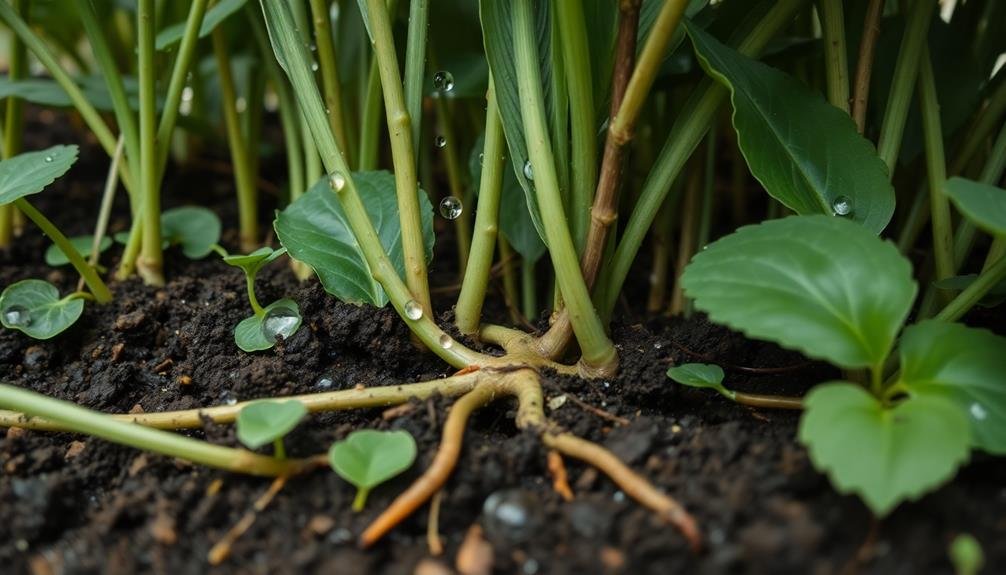
Moving from how greywater is applied, let's consider its effects on plants and soil. When you use greywater for irrigation, you're introducing various chemicals and microorganisms into your garden ecosystem. These can impact plant health and soil structure in both positive and negative ways.
Greywater often contains nutrients like nitrogen and phosphorus, which can benefit plant growth. However, it may also carry salts, oils, and detergents that can accumulate in the soil over time. This buildup can alter soil pH, affect nutrient availability, and potentially harm beneficial soil microorganisms.
You'll need to monitor your plants for signs of stress or nutrient imbalances. Some plants may thrive with greywater irrigation, while others might be sensitive to its contents. Pay attention to leaf discoloration, stunted growth, or unusual wilting.
To mitigate potential issues, rotate your greywater usage with fresh water irrigation periodically. This helps flush out accumulated substances and prevents long-term soil degradation.
Additionally, choose plant-friendly, biodegradable household products to minimize harmful chemicals in your greywater. By understanding these interactions, you can maximize the benefits of greywater reuse while protecting your garden's health.
Frequently Asked Questions
Can Greywater Be Used to Water Edible Plants or Vegetables?
You can use greywater to water edible plants and vegetables, but you'll need to take precautions. It's best to apply it directly to the soil, avoid using it on leafy greens, and make certain it's free from harmful chemicals.
How Often Should Greywater Systems Be Maintained and Cleaned?
You should maintain and clean your greywater system regularly, typically every 3-6 months. Don't forget to check filters, pipes, and storage tanks. It's essential to prevent clogs and bacterial growth for ideal performance and safety.
Are There Any Legal Restrictions on Greywater Reuse in Residential Areas?
You'll find that legal restrictions on greywater reuse vary by location. Check your local regulations, as some areas require permits or have specific guidelines. Generally, you can't use greywater for drinking or indoor uses like toilets.
What Types of Plants Are Best Suited for Greywater Irrigation?
You'll find that drought-tolerant plants, fruit trees, and ornamental shrubs thrive with greywater irrigation. Avoid using it on root vegetables or leafy greens. Choose plants that can handle slightly alkaline water and potential soap residues.
Can Greywater Be Used for Flushing Toilets or Other Indoor Purposes?
Yes, you can use greywater for flushing toilets and other indoor purposes. However, you'll need to treat it properly first. It's crucial to install a dedicated plumbing system and follow local regulations to guarantee safety and efficiency.
In Summary
You've learned about the key health factors to take into account when reusing greywater. Remember, it's essential to manage microbial growth, monitor chemical contaminants, and control storage conditions. Be mindful of your application method and potential exposure. Don't forget to reflect on how greywater interacts with plants and soil. By keeping these factors in mind, you'll be better equipped to safely and effectively reuse greywater while minimizing health risks to yourself and others.

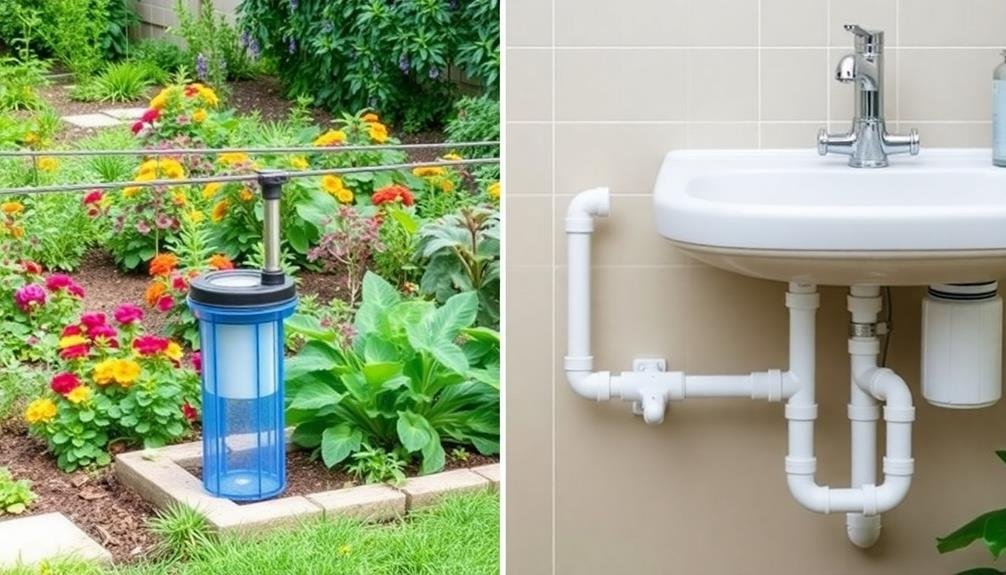


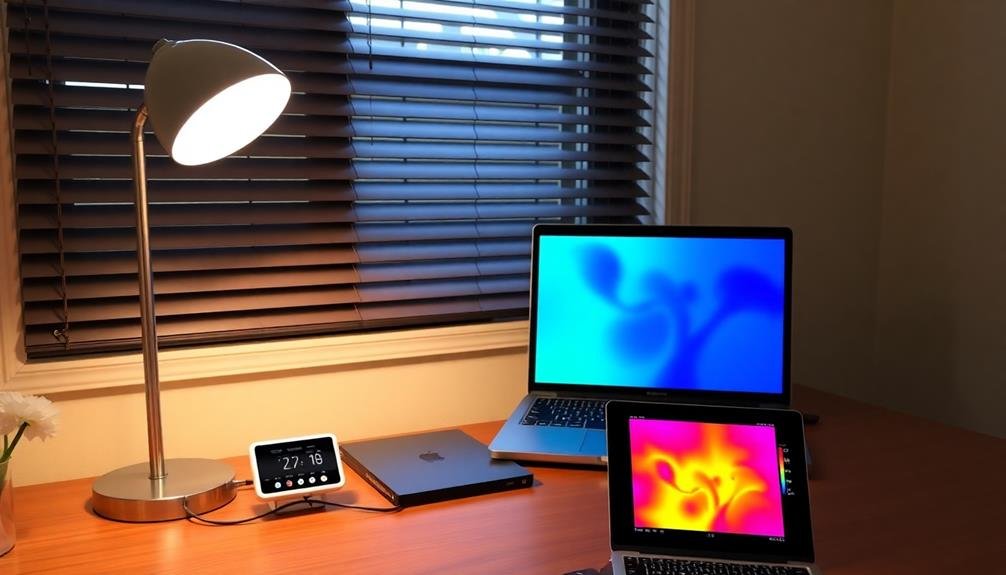
Leave a Reply